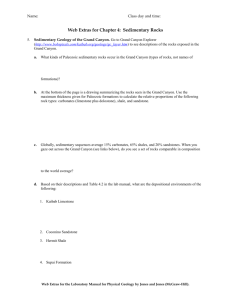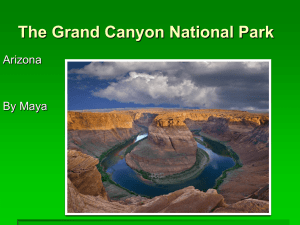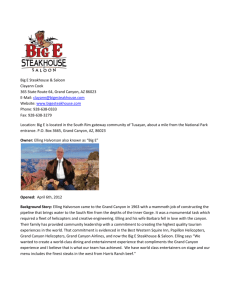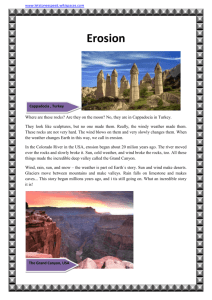Surviving the Desert
advertisement
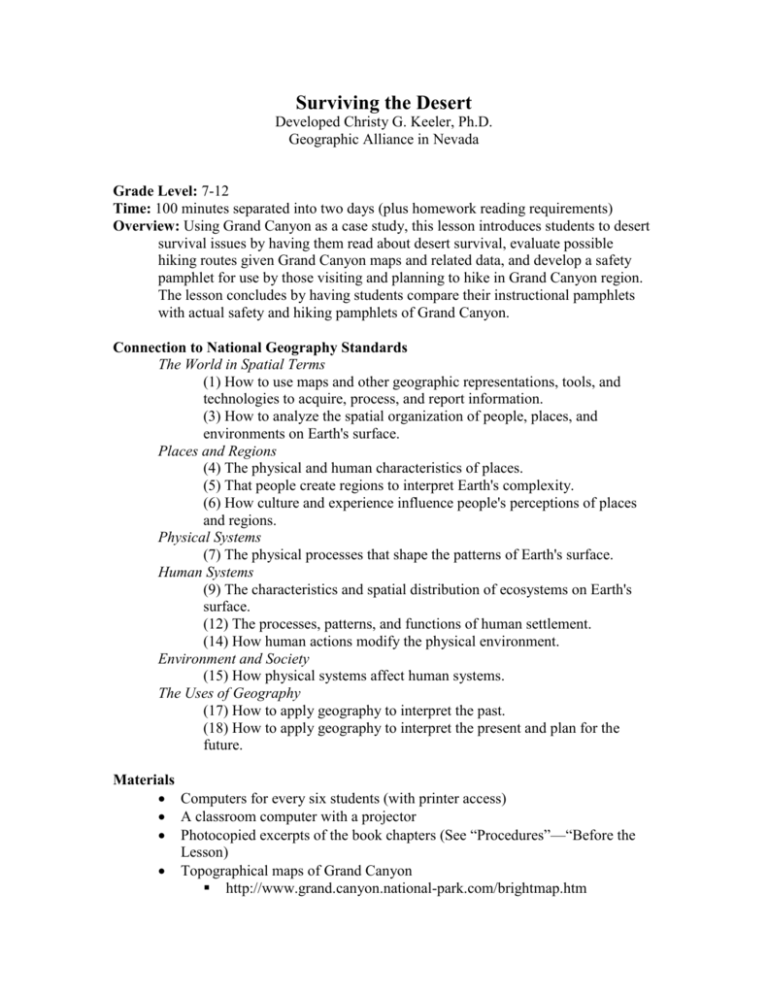
Surviving the Desert Developed Christy G. Keeler, Ph.D. Geographic Alliance in Nevada Grade Level: 7-12 Time: 100 minutes separated into two days (plus homework reading requirements) Overview: Using Grand Canyon as a case study, this lesson introduces students to desert survival issues by having them read about desert survival, evaluate possible hiking routes given Grand Canyon maps and related data, and develop a safety pamphlet for use by those visiting and planning to hike in Grand Canyon region. The lesson concludes by having students compare their instructional pamphlets with actual safety and hiking pamphlets of Grand Canyon. Connection to National Geography Standards The World in Spatial Terms (1) How to use maps and other geographic representations, tools, and technologies to acquire, process, and report information. (3) How to analyze the spatial organization of people, places, and environments on Earth's surface. Places and Regions (4) The physical and human characteristics of places. (5) That people create regions to interpret Earth's complexity. (6) How culture and experience influence people's perceptions of places and regions. Physical Systems (7) The physical processes that shape the patterns of Earth's surface. Human Systems (9) The characteristics and spatial distribution of ecosystems on Earth's surface. (12) The processes, patterns, and functions of human settlement. (14) How human actions modify the physical environment. Environment and Society (15) How physical systems affect human systems. The Uses of Geography (17) How to apply geography to interpret the past. (18) How to apply geography to interpret the present and plan for the future. Materials Computers for every six students (with printer access) A classroom computer with a projector Photocopied excerpts of the book chapters (See “Procedures”—“Before the Lesson) Topographical maps of Grand Canyon http://www.grand.canyon.national-park.com/brightmap.htm http://www.bobspixels.com/kaibab.org/usgs/gc_gc_ed.htm Hiking guides produced and distributed to all visitors by the National Park Service about Grand Canyon (i.e., the information provided at the entrance to the national park)—Enough for each group of six students to have a copy of each circular AND the below trail maps of Grand Canyon (one of each for each group of six) Grand Canyon Trail Guide: Bright Angel (http://www.grandcanyonassociation.org/Merchant2/merchant.mvc?Scree n=PROD&Store_Code=GCA&Product_Code=M10070&Category_Code= &Search=trail+bright+angel&Search_Type=OR&Offset=49) Grand Canyon Trail Guide: Havasu (http://www.grandcanyonassociation.org/Merchant2/merchant.mvc?Scree n=PROD&Store_Code=GCA&Product_Code=M10085&Category_Code= &Search=trail+bright+angel&Search_Type=OR&Offset=50) Objectives Students will identify geographic structures of desert regions with specific attention to Grand Canyon. Students will identify dangers associated with desert survival. Students will prepare cohesive plans for surviving desert climates and physical geographical structures. Procedure Day One Opening Project a topographical map of Grand Canyon (http://www.jcu.edu/philosophy/gensler/escalante.gif) and, in their journals, have students propose routes for hiking from the rim to the river, justifying their choices, and stating issues they might face when making the trek. Development 1. Discuss student responses during their review of the topographical map, focusing on the abrupt elevation changes common in Grand Canyon. Next, in lecture format, briefly explain the geography of the region by addressing the history, geology, flora, and fauna of the region while addressing the broader issue of deserts. The following resources may prove helpful: http://www.destination360.com/northamerica/us/arizona/images/s/grand-canyon-maps.jpg http://away.com/gifs/states/az/m_gcnpov.gif http://www.arizona-leisure.com/grand-canyon-history.html 2. Ask students what issues they feel may be important when hiking in Grand Canyon, recording their answers on the board. 3. Place students in groups of six and have each group begin to design a pamphlet that could be given to travelers to Grand Canyon who intend to hike in the park’s region. Specific attention should address dangers of the Canyon and safety recommendations. Groups should choose their design and begin input basic information before the end of class. **Have students use pre-made pamphlet templates (available in the Project Gallery of Microsoft Word) to save time on design, therefore allowing more time to focus on content. Closing Inform students that for homework they will read information about dangers affecting individuals either hiking in deserts or visiting Grand Canyon. They must come prepared with their homework for class tomorrow. Homework Distribute copies of the following chapters and book sections to students to read for homework. Provide each student with a different reading to ensure the class completes all readings. Every student in each group of six should have a different reading and both the Desert Survival and Death in Grand Canyon books should be represented in each group. Student must prepare a brief assignment including the following items: The name of their reading A brief description of what they read Five tips for hiking in desert regions or Grand Canyon extrapolated from their reading The readings include: 1. Desert Solitaire by Edward Abbey (http://www.amazon.com/DesertSolitaire-EdwardAbbey/dp/0671695886/ref=sr_1_1?ie=UTF8&qid=1249049554&sr=8 -1)—“Water” and “The Heat of Noon: Rock and Tree and Cloud” [Note: The “Water” chapter includes some inappropriate language. Additionally, both chapters require high reading levels and may include adult content.] 2. Desert Survival: Tips, Tricks, and Skills by Tony Nester (http://www.amazon.com/Desert-Survival-Tips-TricksSkills/dp/0971381119/ref=sr_1_1?ie=UTF8&qid=1249049606&sr=81)—Assign each of the following sections, one for each student: “Physiology of Humans in the Desert” “Desert Hazards” “Anatomy of a Survival Situation” “The Basic Skills of Survival” “Outfitting Your Vehicle” “Obtaining Water in Arid Regions” “Desert Survival Shelters” “Firemaking Skills” “Knife Uses and Safety” “Signaling for Rescue” 3. Over the Edge: Death in Grand Canyon by Michael Ghiglieri and Thomas Myers (http://www.amazon.com/Over-Edge-Death-GrandCanyon/dp/097009731X/ref=sr_1_1?ie=UTF8&qid=1249049638&sr= 8-1)—Assign all chapters EXCEPT those on suicide and murder. Assign at least one student to each of the following book sections: Chapter One (Falls): Chapter Introduction AND “Falls from the Rim,” “Falls within the Canyon” Chapter Two (Environmental Deaths): Entire chapter Chapter Three (Flash Floods): Entire chapter Chapter Four (Killer Colorado): Chapter Introduction AND “Lethal Errors Made While Running the River,” “River Crossers Who Didn’t,” “Swimmers Who Drowned Elsewhere in the Colorado,” “Swimmers Who Drowned between Phantom and Pipe Creek” AND “Swimmers Who Drown Elsewhere in the Colorado,” “Accidental Swimmers Who Fell in from Shore” AND “Mysterious Disappearances Who Drowned from Camp,” “Lessons of Safety & Survival from the Grand Canyon Colorado” Chapter Five (Air): Entire chapter Chapter Six (Freak Errors and Accidents): “Rock Falls,” “Venomous Creatures,” “Freak Errors and Accidents” Epilogue (Lessons): Entire section *In larger classes, have multiple students read the same passage, but limit the number of students per passage to ensure an even distribution of readings. * If there are not enough books for students to take home to complete the readings, copy chapters or chapter sections for each student. In some cases, it is possible to copy two pages on a single side of paper, for a total of four pages per piece of paper. Require students return their reading passages for use with future classes. Day Two Opening As students enter the classroom, have each student choose one tip for hiking in desert regions or Grand Canyon from their homework assignment and write it on the board. [For smaller classes, have each student write two tips on the board.] Development 1. Have students continue on their pamphlets. Halfway through the class period, have students print out their pamphlets. (They will turn these in for grading after class.) 2. Provide each group with hiking guides from Grand Canyon (see “Materials”) and have them review these to identify hiking and survival tips. Each group will create a T-chart titled “Pamphlet Comparisons.” On the left, they will write “Recommended Improvements for Our Pamphlet” and the right will write “Recommended Improvements to Their Pamphlets.” Student groups will complete the T-chart and turn it in along with their pamphlet. Closing Have a brief discussion about what students learned through this two-day unit. Assessment 1. Provide credit based on student ability to actively collaborate with a group to complete the pamphlet and their ability to collaborate in the whole class group for the project analysis. 2. Grade the quality of student responses on their homework assignment. 3. Grade students on the quality of information included in the pamphlet and their T-charts, taking into account the collaborative nature of the assignments. Extending the Lesson Have students replicate this lesson for a national park in another region and ecosystem of the United States. Have students evaluate their group pamphlet and create a new pamphlet on their own. The pamphlet should combine content from the original groupgenerated pamphlet, class discussions and lecture, and official park documents. This lesson is available at http://keelerthoughts.blogspot.com/2009/07/surviving-desertlesson-plan.html


